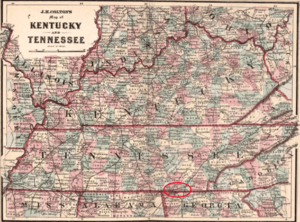Chattanooga in the American Civil War facts for kids
Chattanooga, Tennessee, was a very important city during the American Civil War. It was a major railroad hub, meaning many train lines met there. This made it a key spot for moving supplies and soldiers. The city also had high ground, like mountains and ridges, which both sides wanted to control. When Union (Northern) soldiers were trapped in Chattanooga, General Ulysses S. Grant found a way to get supplies to them. This made President Abraham Lincoln very happy.
Contents
Tennessee's Divided Loyalties
Tennessee was the last state to join the Confederacy in June 1861. This was because people in the state were deeply divided. The eastern part, including Chattanooga, was mostly loyal to the Union (the North). This area had mountains and fewer enslaved people. The western part of Tennessee had many enslaved people and supported the Confederacy (the South).
At one point, some people even suggested that East Tennessee should become its own state and stay with the Union.
When Tennessee left the Union, Andrew Johnson was the only Southern senator who stayed in the U.S. Senate. This was a very brave thing to do and put his life at risk. President Lincoln trusted him and made him the military governor of Tennessee in March 1862. Later, Johnson became Lincoln's running mate in the 1864 election and eventually became president himself.
Tennessee actually sent more soldiers to fight for the Union than any other Confederate state.
Key Troop Movements in Chattanooga
Chattanooga was a vital railroad center, connecting important Southern military bases. Because of this, it was deeply involved in the Confederate war effort from the beginning. Even so, some local people resisted the Confederacy.
The city stayed in Confederate hands until September 1863. After that, the Union army occupied it for the rest of the war. Union General William Rosecrans retreated to Chattanooga after a big defeat at the Battle of Chickamauga. Confederate General Braxton Bragg then surrounded the city, trapping the Union soldiers.
General Ulysses S. Grant arrived and managed to open a supply line, bringing food and supplies to the trapped Union troops. Grant then led his soldiers to drive the Confederates off Lookout Mountain. He then completely defeated them at Missionary Ridge. After these victories, Chattanooga became a key starting point for General William T. Sherman's important campaign into Georgia in 1864.
Important Battles Around Chattanooga
First Battle of Chattanooga (June 7–8, 1862)
This was a raid by Union General James S. Negley. He wanted to capture Chattanooga, which was held by the Confederates. His soldiers fired cannons at the city for a long time. The Confederate gunners fired back, but they were not very organized. General Negley pulled his troops back on the second day. It was a small Confederate victory. However, it showed that Union forces could strike deep into Confederate territory.
Second Battle of Chattanooga (August 21 - September 8, 1863)
Union General William S. Rosecrans used a clever trick here. He shelled the city from the northeast to make Confederate General Braxton Bragg think that was where the main attack would come from. Meanwhile, Union troops were secretly gathering southwest of the city. When Bragg realized what was happening, he retreated into Georgia. This allowed the Union army to occupy Chattanooga without a major fight.
Chattanooga Campaign (Sept. 21 – November 25, 1863)
After a tough loss at the Battle of Chickamauga in Georgia, General Rosecrans's army retreated into Chattanooga. They were surrounded by General Bragg's Confederate forces and faced surrender. The Union soldiers were losing hope. Luckily, General Grant arrived with other important generals like Thomas and Sherman to help. Here are the main events of this campaign:
‘Cracker Line’ (October 26–28)
The Union army badly needed food and supplies. They captured a ferry crossing on the Tennessee River. This allowed them to create a safe supply route. The starving soldiers were so happy they called it the "Cracker Line" because they finally got food.
Battle of Wauhatchie (October 28–29)
The Confederates tried to take back the Cracker Line. Many of their orders got mixed up in the dark. The Union soldiers, led by Joe Hooker, were also a bit disorganized. But they managed to hold onto the supply route.
Battle of Lookout Mountain (November 24)
The Confederate position on Lookout Mountain seemed impossible to attack. Their cannons couldn't aim low enough to hit the Union soldiers below. In a thick fog, General Hooker's troops climbed the mountain and drove the Confederates off the peak. As the fog cleared, the Union flag could be seen flying high, a sign of victory.
Battle of Missionary Ridge (November 25)
General Grant ordered his soldiers to capture the rifle pits at the bottom of Missionary Ridge. But, on their own, the Union soldiers kept going. They charged all the way up to the top of the ridge. This was a surprising and huge victory for the Union.
Battle of Ringgold Gap (November 27)
After their defeat, the Confederates retreated into Georgia. Grant tried to capture them as they left. However, Confederate General Pat Cleburne and his soldiers fought back strongly. They pushed the Union forces away with very few losses. Grant decided not to chase them further.


